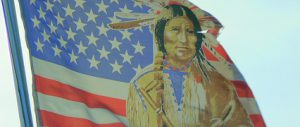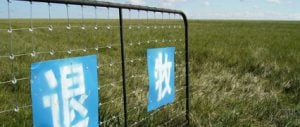The Lakota, a division of other Sioux nations including Dakota and Nakota, were once a nomadic people who roamed prairies and plains, hunting buffalo over a vast area stretching from Wisconsin to the Bighorn Mountains of Wyoming, north into Canada, and south to Kansas.
Tribal legends traced their origins to the Black Hills of today’s South Dakota, and these mountains, where white people eventually carved the images of four US presidents into Mount Rushmore, are among the seized territories that are most profoundly regretted and contested in the US court system today.
The Lakota, the largest group of Sioux, were further subdivided into bands including the Oglala, Hunkpapa, and five others. When the reservations were established, all Indians had to “enroll” in a tribe, and today the Pine Ridge Indian Reservation is the home to the Oglala Sioux.
The traditional diet consisted of buffalo, a lean, high-protein food, supplemented by wild turnips, chokecherries, and a few domesticated vegetables, such as corn and squash, acquired through trade with other tribes. Early contact with white people rested primarily on the fur trade; Fort Laramie was built in 1834 to facilitate the trade in buffalo hides after the beaver had been trapped-out. French-descended fur traders intermarried with the Indians and produced “half-breed” children, who served as interpreters and facilitated further fruitful contacts between whites and the Sioux.
By the mid-nineteenth century, however, buffalo began to disappear as whites armed with guns slaughtered them en masse in order to harvest their tongues, which were considered a delicacy. This deeply offended the Indians, who used every bit of the animal for food, shelter, clothing, and religious ritual. The Oregon Trail toward the Pacific Northwest passed through Fort Laramie and the influx of whites threatened Lakota sovereignty and livelihood.
A series of battles ended with the famous treaty of 1868, in which the United States recognised the entire western half of South Dakota (which included the Black Hills) as the Great Sioux Reservation as well as eastern Wyoming as “unceded Indian territory.” No Americans were to be allowed into these areas except to trade and conduct government business. Importantly, no changes were to be permitted to the treaty unless three-quarters of all adult Indian males signed and, today, court challenges to subsequent US seizures of Indian lands rest on this provision, since the signatures on documents that subsequently modified the treaty were incomplete.
As more gold was confirmed through General George Armstrong Custer’s famous 1874 expedition, the United States tried to purchase the Black Hills, and an enormous gold rush began. The Indians refused to sell, for they had no concept of land ownership; the leader Black Hawk commented, for example, “My reason teaches me that land cannot be sold. The Great Spirit gave it to his children to live upon. So long as they occupy and cultivate it, they have a right to the soil. Nothing can be sold but such things as can be carried away.”
The Indians were pressured to relocate. Many of them did so, as the buffalo were nearly gone and there was little hunting. The US Army then ordered all Indians to go to their “agencies” or reservation centres, and those who refused were labelled as “hostile”. A series of “Powder River” skirmishes culminated in the 1876 Battle of Little Big Horn against General Custer, which made leaders such as Crazy Horse famous. This was the last major victory for the Indians and the beginning of a precipitous decline in their fortunes.
In 1877, the Indians were forced, through starvation induced by the withholding of rations, to give up the Black Hills. Even then, most refused to sign the new treaty, and only one-tenth of the signatures were obtained, not the required three-quarters. By 1878, Pine Ridge and other reservations were well established, and later agreements forced upon the Indians permitted immigrant farmers and miners to colonise other parts of Indian lands.
The remaining patchwork of Indian reservations is but a shadow of the territory originally promised in the peace treaty of 1868. The buffalo have been decimated, the tall-grass prairies that once stood as high as a man’s shoulders has gone to desert through overgrazing and farming, the last of the passenger pigeons, which once darkened the skies for days through their great migrations, died in 1914 in a zoo. In the name of modernisation and the founding of a “New World” based on what were believed to be limitless resources, the ecosystems of the great American plains were utterly and irretrievably transformed.
By the late-nineteenth century, then, the Sioux Indians had lost all trace of their traditional hunting lifestyle. Their livelihood was gone, they were forbidden to pursue nomadic ways, and they were forced into complete dependency on the government for food, as legal wards of the state.
In the last years of the century, in what was perhaps a symptom of the profundity of the cultural depression, a prophetic mystical movement spread all over Indian lands, sparked by a visionary named Wovoka, a Paiute Indian. His vision was that Indians should dance a “Ghost Dance” that would revive their dead ancestors, bring back the buffalo, and remove the whites from America. The Oglala Lakota Sioux adopted this vision with fervour and added the idea that wearing a special “Ghost Shirt” would protect the wearer from white people’s bullets.
By 1890, hundreds of Indians were dancing. The whites panicked and tried to ban the dance, and the famous spiritual leader Sitting Bull, a supporter of the dance was killed. Tensions mounted, leaving some Indians to move into the badlands, where they were stopped by members of the 7th US Cavalry. Eventually, Chief Big Foot surrendered, and the group was escorted back toward Pine Ridge Reservation. As they camped at Wounded Knee Creek, shots were fired. Believing that the ghost shirts would protect them, the Indians failed to protect themselves and a great massacre of hundreds of Indian men, women and children took place. The December 29, 1890 massacre at Wounded Knee is considered the end of Indian efforts to resist the white man, and the beginning of more than a century of grief and loss of cultural identity.
Americanisation and forcible assimilation followed. Well-meaning missionaries from different Christian sects were assigned Indian reservations so they would not need to compete with each other; the Episcopal Church received rights to Pine Ridge when president Ulysses S Grant installed religious clergymen as government agents (thus departing from the principle of separation of church and state). Believing that they were doing the right thing for the poor heathens, they taught that their religion was best and the Indians were ignorant devil worshippers. They took Indian children out of the reservation to faraway boarding schools, where their long braids were cut and they were taught that their parents were savages. Children were forbidden to speak Lakota language in school. Eventually, many Indians internalised the message that their culture was inferior and developed a profound self-loathing that psychologists recognize as a form of massive cultural trauma.
Traditional government was replaced by that of the Bureau of Indian Affairs (BIA), which hired cooperative Oglala to enforce white people’s laws. Although land was supposed to be assigned to Indians, the Indians, as noted above, did not have a concept of land ownership and much of the land was tricked away from them. Subsequent generational claims made land-tenure rights impossibly complicated.
There were further twists in the history when, in 1934, the Indian Reorganization Act allowed tribes to write constitutions and the BIA stopped suppressing local culture. This policy changed once again in the 1950s, when the US government temporarily pursued a policy of “termination” or ending tribal life and encouraging relocation out of the reservation to other cities in the United States. Few Indians were equipped with the skills necessary to make it and most eventually returned to “the rez”.
Today, Indian males have little function as they are completely dependent on the government. Families have no tradition of going to work and holding jobs. The lands that they have been given are relatively unfertile and lacking in natural resources; the Black Hills lands, rich in minerals, were seized and in any case traditional Sioux beliefs would have forbidden digging into the earth. Tribal governments do not hold real power, but they are nonetheless factionalised and corrupt. In the 1960s, a militant group called the American Indian Movement embarked on a struggle against corrupt conservatives who were running the reservation. They marched to Washington and took over the BIA for several days; when they returned to the reservation, violent skirmishes among factions ended in a 1973 four-month standoff against Federal marshals on the site of the old Wounded Knee Massacre. Bitterness over these events lingers even today.
In 1975, the Indian Self-Determination and Education Assistance Act allowed for greater self-government, including the right of Indians to run their own police force and to control the schools. Meanwhile, lawsuits pursuing land claims under the treaty of 1868 made their way all the way to the US Supreme Court, which ruled in 1980 that the Indians were entitled to compensation for the theft of their land, plus interest. They handed down a monetary judgment for the US$17 million (116 million yuan) initial offering price, plus interest, which today amounts to more than US$400 million.(2.7 billion yuan).
However, the Sioux have refused to accept the money, arguing that their land is not for sale and that they were not properly represented by their attorneys. To this day, many Lakota argue for the return of the Black Hills under the terms of the treaty of 1868 and continue to pursue legal and diplomatic avenues to get back their lands.
Judith Shapiro is director of the Natural Resources and Sustainable Development MA Program at the School of International Service, American University, Washington DC.
NEXT: A lesson for China?
Homepage image from Wikipedia shows the Battle of Little Big Horn.



